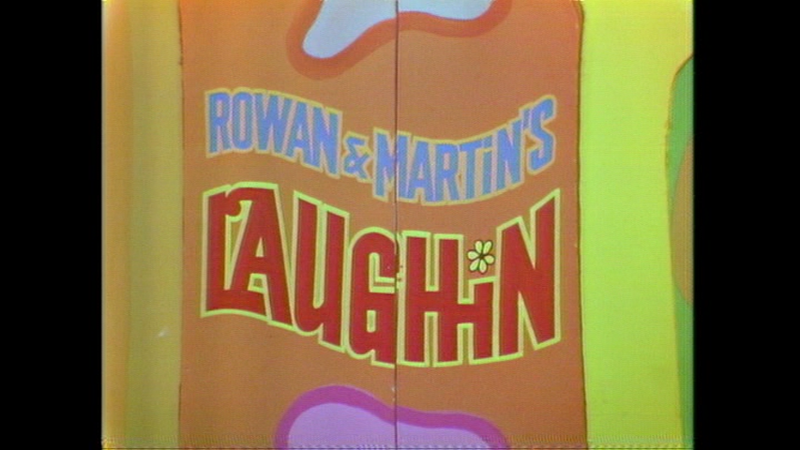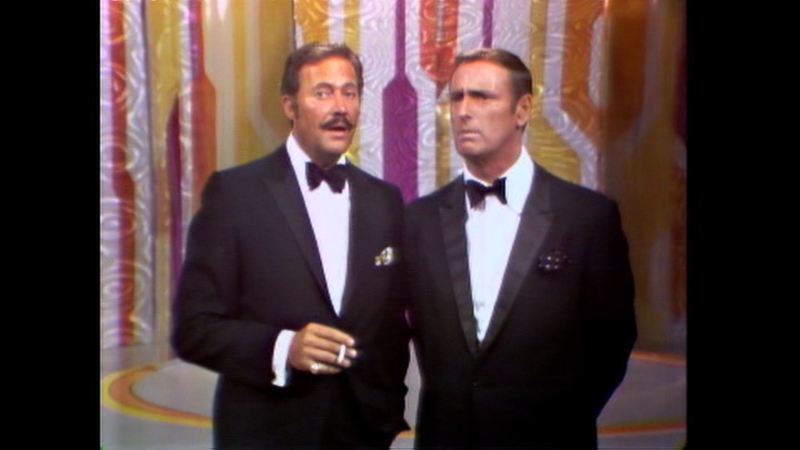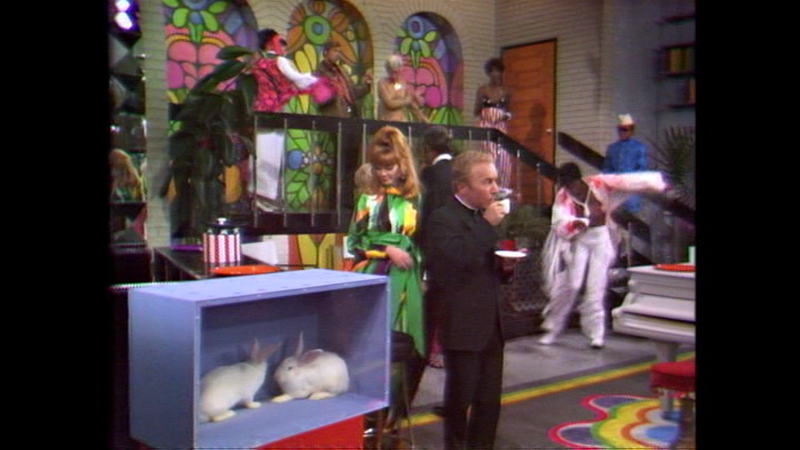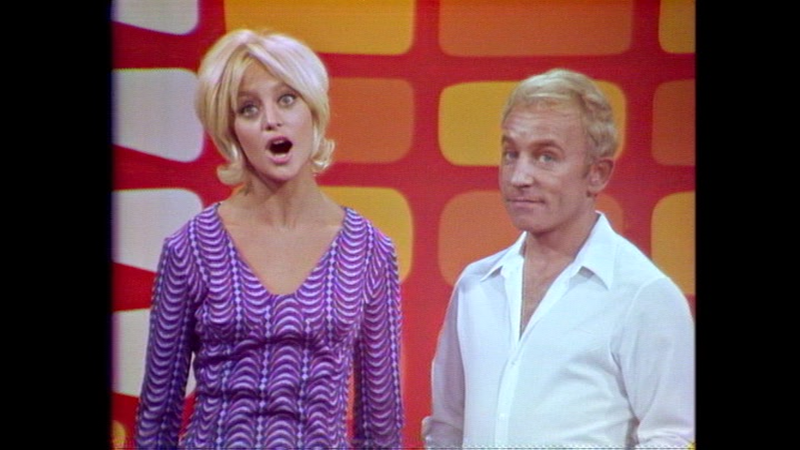| Reviews & Columns |
|
Reviews DVD TV on DVD Blu-ray 4K UHD International DVDs In Theaters Reviews by Studio Video Games Features Collector Series DVDs Easter Egg Database Interviews DVD Talk Radio Feature Articles Columns Anime Talk DVD Savant Horror DVDs The M.O.D. Squad Art House HD Talk Silent DVD
|
DVD Talk Forum |
|
|
| Resources |
|
DVD Price Search Customer Service #'s RCE Info Links |
|
Columns
|
|
|
Rowan and Martin's Laugh-In: The Complete Series
Funny chaos that's as relevant as ever

Reviewer's Bias*
Loves: Laugh-In, Henry Gibson, Jo Anne Worley
Likes: Goldie Hawn, Sammy Davis, Jr.
Dislikes: Formulaic comedy
Hates: Casual racism, how awful things don't just go away
The Show
A controversial president drowning in scandal, Republican leadership ignoring the poor, social unrest, civil-rights battles, racism, clashes over reproductive rights, gender inequality, international strife...boy, the late ‘60s were a mess, huh? Thank goodness we've come a long way over the past 50 years. I mean, if we hadn't, then revisiting Dan Rowan and Dick Martin's Laugh-In would feel incredibly relevant and frustrating, watching the young adults of a bygone era lampoon societal problems that seemed to have been met with great progress only to be reignited by an ignorant, hateful and highly-vocal subset of America too self-absorbed and ill-informed to not allow themselves to be manipulated into going against their best interests.
Anyway…Rowan & Martin's Laugh-In, which ran for six seasons on NBC (from 1968-1973), was, for a few years, the biggest show on television. A variety show that blended comedy and music with a heavy vaudeville bent, it was a pioneering TV series, thanks to a manic sense of humor, a heavy focus on politics and social commentary and a frenetic pace built on head-spinning editing that wouldn't become a norm until decades later. Though the show was formulaic in many ways, with regular bits like the famous dance parties full of one-liners and the show-ending joke wall (again, full of one-liners), as well as themed segments like the "The Quickies", "Sock It To Me Time", "It's a Mod, Mod World" and "A Salute to…" it was hardly a rigidly constructed concept. Rather than put together a show as one cohesive creation, guest stars and sketches would be shot en masse and then spread throughout several episodes, surrounded by one-liners and non sequiturs, with no need for connective tissue between them. When hammering the viewer with jokes so rapidly (some on-screen for less than a second) you don't have to land every laugh, because there likely will be a good one coming up soon, and when you really hit, the laughs can carry you through the next few bits.
Right off the bat, the cast was a tremendous asset, with a great core crew of performers, including terrific utility players Henry Gibson and Arte Johnson, versatile funny lady Ruth Buzzi, the game Judy Carne and the larger-than-life Jo Anne Worley, not to mention short-time regular Eileen Brennan. Over the years, the mix would change, adding over-the-top Alan Sues (whose mannerisms were played for gay stereotype laughs, while at the same time being one of the earliest obvious gay representations on mainstream TV), the delightful Chelsea Brown (who was more than the show's token minority) and, easily the show's most important non-original cast member, Lily Tomlin, who competed with Buzzi for the title of MVP for her four years, with a slew of memorable characters, including aggressive phone operative Ernestine and observant five and a half-year-old Edith Ann.

Of course, the performer most identified with the show was Goldie Hawn, the blonde giggle machine who lent so much to the series' loose, goofy feel for the first three seasons. (Of course her "performance" in a bikini in the show's trademark go-go body graffiti segments did nothing to hurt her profile on the show.) Thanks to her frequent flubs and her accompanying adorable reactions to them, as well as a "dumb blonde" act that never felt forced or mean, Hawn was able to earn laughs for even the silliest, most telegraphed jokes. That was key, because Laugh-In's stock in trade was the obvious pun, getting plenty of mileage out of the kinds of jokes that fill a grade-schooler's book of gags. But they could get away with it because they made it all look like a great deal of fun.
The set-up of the show, with its collection of pre-taped bits and pieces, allowed for participation from plenty of players, and the show's tremendous popularity meant everyone wanted to take part. As a result, you got a bit of everything, from charming oddities like the falsetto-singing, ukelele-playing Tiny Tim to brilliant fits like Flip Wilson and Barbara Feldon (an incredibly underrated comedic actress), with some of Hollywood's biggest names stopping by to play, along with newsmakers like then-Presidential candidate Richard Nixon. When you've got director Otto Preminger, Liberace and Kirk Douglas--in a single episode!--you've got something interesting going on. It would be hard to find a recognizable name from the era that didn't do something on Laugh-In, be it Johnny Carson, Peter Sellers, Rod Serling, Vincent Price or The Monkees.
Of course, the show is called Rowan and Martin's Laugh-In, so mention must be made of the titular Dan Rowan and Dick Martin, the ringmasters who keep things moving as hosts, while taking part in sketches here and there and leading the show's news segment. Rowan is mainly the cigarette-smoking straight-man to Martin's dopey ladies' man, and though they repeat the same rhythms in their segments, the chemistry between them and with the celebrity guests is perfect for reining in the show's chaos and maintaining an old-school variety-show vibe. As easy as it would be to dismiss their contributions to the show, without their moments of lower-key comedy giving structure and breathing room to the show, Laugh-In could have become too much to bear.
Though much of the surreal and/or nonsensical comedy, like the first tongue-twisting Farkle family sketch or any of the censor-baiting mentions of Funk & Wagnalls, and pretty much all of the social and political comedy still resonates (at least if you understand the references), the more vaudevillian song-and-dance bits, punctuated by gags, tend to be a drag, as the music isn't particularly engaging, the dancing isn't very impressive and the jokes usually aren't very funny (especially when they are on their third or fourth pass, as the show loved to repeat a punchline.) When you place these extended, simply less-enjoyable pieces in amongst the machine-gun comedy of the rest of the show, they become a speedbump for the momentum, and quickly become fast-forward fodder, which is a real problem when you have multiple such segments in any given episode.
Fortunately, most of the show is just silly gags and puns, which doesn't require a great deal of knowledge about the ‘60s and ‘70s. (Though when an obscure celebrity or topic drives you to Google, you may learn something interesting, as was the case when I tried to find out who Totie Fields was.) Unfortunately, in amongst the goofy comedy and wordplay are the social mores of the time, which were hardly as enlightened as we would hope they are today. As a result, the show trafficks in a great deal of comedy based in racial, gender, sexuality and ethnic stereotypes, with a particular focus on jokes about the Chinese, Native Americans and Polish (with many of the musical intros to the series' news segments being very awkward to watch, especially with the ladies in black bodystockings to play dancing tribal Africans.) Though such moments are relatively frequent, the show also displays a heavy progressive mindset, with bigots and racists (like George Wallace) a regular target for its barbs, and integrated couples being the norm, without any attention being drawn to it.
The show struggled through its final two seasons, as the majority of the original main cast had left (with the exception of the hosts, Buzzi and announcer Gary Owens) while pressure from the network (on behalf of the Nixon administration) put the brakes on the show's political comedy. Even the guest stars and cameos took a hit, with far fewer famous faces dropping by, though there was still the occasional great get like Robert Goulet, Charles Nelson Reilly, Johnny Cash, Joe Namath and Sammy Davis, Jr. Though Buzzi, Tomlin and new recruit Richard Dawson (a solid presence who leaned on impersonations of Groucho Marx and W.C. Fields) helped to keep the show going, it just didn't feel the same, as the atmosphere of joy and manic fun that powered earlier seasons was long gone. A sense that the show had jumped the shark was hard to ignore when two kid actors were added to the cast (making the show's punnery feel even more childish) along with season six's addition of Lisa Farringer, a heavily-accented beauty with one awful bit that was beaten to death, and Sarah Kennedy, an obvious attempt to find a new Goldie Hawn that fell flat. The problems couldn't have been made more obvious with episode 100, when several of the original cast members (including Johnson, Carne, Worley and Gibson) came back and outshined the regulars (a phenomenon SNL's experienced in recent years.) Though the last episode teases Jean Stapleton as next week's guest, there would be no more, and Laugh-In ended with a whimper.

The DVDs
The complete, six-season run of Rowan & Martin's Laugh-In, 140 episodes in all, arrives in a massive 38-disc set, which is split up into seven keepcases, each (with the exception of the bonus disc's Thinpak case) with dual-sided trays and a booklet that offers info on each DVD and episode, including airdates, guest stars and segments. The cases and an additional booklet are held in a large box with a cover (that doesn't seem too sturdy, as two corners were town on arrival.) The discs have static, anamorphic widescreen menus offering a choice to play all, select episodes, adjust languages and check out extras (where applicable.) There are no audio options, but subtitles are available in English.
The Quality
Disclaimers at the start of each disc explain that the video and audio has some inherent problems, with the main issue being inconsistency, as there were difficulties during the remastering process due to the show's editing style, with the early seasons suffering more than the later ones. Aside from that, the columnboxed, anamorphic widescreen transfers on these shows look quite good, with solid color and a good amount of fine detail, though the footage shot early in the show's run and on-location on film tends to be softer, with less contrast and duller color. Some episodes (and even some segments inside of episodes) aren't quite as vibrant as others, but overall there's not much to complain about in terms of the image, which has only a minimal amount of damage and which shows no obvious issues with digital distractions (outside of the issues that accompany the medium it was captured on.)
The audio, presented in center-balanced Dolby Digital 2.0 tracks, is, during most episodes, strong and easily understandable (as long as the accent or clarity of the speaker allows for it.) Music has sufficient heft, as do the frequent sound effects. There are a few episodes that will require you to reach for your remote, because the volume inexplicably goes down. This is infrequent however, and is limited to a select few episodes during the first two seasons.
The Extras
Extras are included on the first disc of each of the first four seasons. For season one, the bonus content starts with the show's pilot episode (53:33), from September 9. 1967. Some of the elements that the show would become known for are there from the beginning, like the party, though a few, like Gladys and the news segment, are slightly different, allowing you to see the development that would later happen.
A new interview with producer George Schlatter (40:35) covers a wide variety of topics, including the creation of the show, its legacy and impact on American culture, the iconic characters and elements. Schlatter, an enjoyable character in his own right, also touches on his own career and his view of how history has repeated itself with recent political turmoil.
14:56 of highlights from the 25th Anniversary Cast Reunion offers a few questions and answers from the 1993 event, which is most notable for the sense of optimism expressed--a distinct difference from the atmosphere 20+ years later.
There are also 24:18 of black and white bloopers, with censored swearing, which aren't as funny as you might hope, but there are a few notable and enjoyable moments, including Buzzi playing "Chopsticks" with her feet, Orson Welles in the midst of a messed-up scene, and Worley attempting to lipsync live to Gibson's voice.
Season two brings an interview with Martin from the early 2000s (20:42), in which he talks about teaming up with Rowan, getting the show started, the show's impact and relation to politics, as well as the modern world of television and his transition to directing.
Then, an interview from the same era with Owens (20:25) offers the delightful chance to listen to that distinctive voice, as he talks about getting the Laugh-In gig, other jobs he had and the famous phrase "beautiful, downtown Burbank", peppering his answers with behind-the-scenes info and a great sense of humor.
Season three starts with a new 9:59 interview with Tomlin, where she talks about how she got her role on the show and her famous Ernestine character, as well as her fights with censors.
An older (early 2000s) interview with Johnson (25:02) goes in-depth on his career and his perspective on Laugh-In, including his hiring, how he learned accents, the show's pioneering status, how he was typecast as a comic actor and the changes in TV comedy over the decades.
For season four, there's another 10:41 from Tomlin, this time focusing on joining the show (including touring with Rowan and Martin) and her kid character, Edith Ann. She also talks about what she feels made the show unique and what it was like to be "the new girl" on the series.
Also on this season is "Still Laugh-In: A Tribute to George Schlatter" (52:50), a 2013 event at Pepperdine University, hosted by Larry King. Featuring tributes from Tomlin, Johnson, Conway, Shirley Maclaine and Worley (still as irrepressible as ever), as well as appearances on video by Hawn and Jay Leno, it's a fun trip down memory lane (particularly thanks to Conway's hilarious segment.) Unfortunately, it's obviously very trimmed down from the actual event, as evidenced by Worley's piece ending abruptly.
A bonus disc holds more extras, including the full 48:52 25th Anniversary Cast Reunion (which makes the highlights from the season one discs superfluous.) Schlatter asks as the host, with Martin, Gibson, Sues, Lloyd, Tiny Tim, Hawn, Buzzi, Owens, Carne, Feldon, Tomlin, Chelsea Brown, Billy Barnes and Barbara Sharma. The Q&A suffers a bit thanks to the sheer number of cast members on hand (you barely hear from many of the participants) but there are lots of enjoyable memories and perspectives shared, while famous friends pop in, including Buddy Hackett, Connie Stevens, James Garner and Conway (who once again steals the show.)
There's another 28:33 from the interview with Schlatter from the season one discs, this time covering several of the celebrity cameos and how he got started with Rowan and Martin, Tomlin, Carne, Owens, Wilson, Dawson, Feldon, Tiny Tim and Hawn. The bits about Hawn are particularly interesting, as they give insight into how her personality on the show was developed. Schlatter's the kind of guy you can just listen to meander through his memories, especially when they involve people like Sammy Davis, Jr. and Laugh-In writer Lorne Michaels (who went on to do other stuff.)
A 19:05 interview with Sues (from the early 2000s) covers his early, ill-fated start with Schlatter in Las Vegas to his time on Laugh-In.
In the box, there's also a nice 32-page booklet. "Rowan & Martin's Laugh-In Memories", which includes a letter from Schletter, lots of pictures and lines from the show, and some behind-the-scenes photos (though there's only two pages of those.)

The Bottom Line
Rowan & Martin's Laugh-In remains unfortunately relevant today, as history seems to be repeating, and the frenetic, chaotic comedy still earns laughs 50 years later, even if many of the references will go forgotten or unrecognized. There's a lot that hasn't aged well, including the stereotype jokes and many of the song and dance numbers, while the last two seasons are a far cry from the first four, but, on the whole, it's a wonderful time capsule of the era and the first three seasons deliver terrifically organic good times.
Time-Life has put together a very impressive package, with the show looking and sounding very good, supplemented by a healthy amount of bonus content for fans to enjoy. There's a much less expensive best-of collection with less than a third of the episodes, but it does have a large percentage of the bonus content, so less-invested viewers might want to lean that way. However, you won't get all the best episodes from the early seasons, so if you're a big fan, this is the only way to go.
Francis Rizzo III is a native Long Islander, where he works in academia. In his spare time, he enjoys watching hockey, writing and spending time with his wife, daughter and puppy.Follow him on Twitter
*The Reviewer's Bias section is an attempt to help readers use the review to its best effect. By knowing where the reviewer's biases lie on the film's subject matter, one can read the review with the right mindset.
|
| Popular Reviews |
| Sponsored Links |
|
|
| Sponsored Links |
|
|
| Release List | Reviews | Shop | Newsletter | Forum | DVD Giveaways | Blu-Ray | Advertise |
|
Copyright 2024 DVDTalk.com All Rights Reserved. Legal Info, Privacy Policy, Terms of Use,
Manage Preferences,
Your Privacy Choices | |||||||











